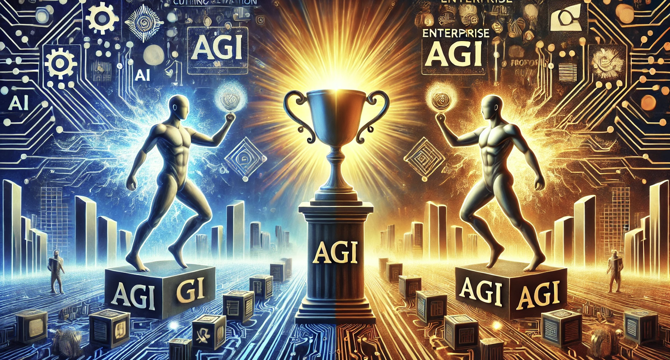Siliconangle
1M
351

Image Credit: Siliconangle
Why Jamie Dimon is Sam Altman’s biggest competitor
- Investors have poured north of $30 billion into independent foundation model players focusing on the false grail of so-called artificial general intelligence (AGI). However, we believe the greatest value capture exists in what is called Enterprise AGI. Private enterprises will capture the majority of value in the race for AI leadership. This report will dig deep into the economics of foundation models and will analyze Enterprise AGI and the untapped opportunities that exist within enterprises.
- The false grail of AGI is often associated with OpenAI Chief Executive Sam Altman, driven by the pursuit of machine business work better than humans. However, removing humans' involvement for decision-making is not as easy as it seems.
- AGI in the enterprise is the ability gradually to learn and adapt white-collar work processes of the firm. Instead of one all-intelligent AGI, it is a swarm of modestly intelligent agents that can collectively augment human white-collar work. Nvidia CEO’s quotes also resonate with this idea of a directory of AIs, some digital, some biological, specialized and skilled, and just generally good at doing things. An all-knowing AGI may not be a viable scenario.
- Private enterprises possess unique data and process advantage that is not in the public domain, which is the key ingredient for its competitive advantage. The proprietary knowledge specific to a business resides in the enterprise's data estate, with foundation models deriving from the transformer, differentiated solely by the data sets that train it.
- LLMs are focused on scaling up its algorithm without recognizing that scaling up Models does not mean scaling their accuracy. The cost of scaling models is becoming unsustainable, and prices will drop like a rock. The investments going to foundation models are misguided, and the massive value capture exists in Enterprise AGI, which is a large opportunity for companies and most of the value created will accrue to these firms.
- Citizen developers give agents goals and guardrails. But just as important, agents can generate plans with step-by-step reasoning that humans can then edit and iterate. Then the exception conditions become learnable moments to help get the agent further down the long tail the next time. Agents can learn from their human supervisors and learn from exceptions while in production. This is the opposite of traditional software where you want to catch and suppress bugs before production. This extension of what an agent can do can create a potentially learnable step to extend the long tail of activities and handle more edge cases.
- Agents can change the economics of achieving that by observing and learning from human actions. The swarm of workflow agents, which are really specialized action models, collectively have the ability to learn and embody all that management knowhow and outperform the most advanced foundation model. The collective intelligence of those agents outperforms the singular intelligence in a frontier foundation model.
- The enterprise automation opportunity is significant but requires specialized knowledge because each process is unique, and it takes more than an AI model to understand an enterprise's processes. The future of enterprise software must not only deliver transactional efficiency and productivity but also be capable of managing and analyzing the complexities of real-time business processes in a unified framework subject to operational, analytic and historical systems.
- Though there are various emerging players exploring the integrated, process-driven source of truth, understanding the nuances of each approach will be critical to building applications that can capitalize on this integrated, process-driven source of truth. The future presents both challenges and a significant opportunity, setting the stage for a new era in enterprise applications, data orchestration, and process alignment.
- Overall, we believe that Enterprise AGI provides a massive opportunity for companies, and most of the value created will accrue to these firms. Private enterprises will capture the majority of value in the race for AI leadership, underscoring the importance of Enterprises' ability to gradually learn and adapt white-collar work processes over an all-knowing AGI.
Read Full Article
21 Likes
For uninterrupted reading, download the app